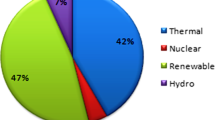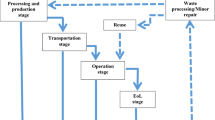Abstract
Purpose
Concentrating solar power (CSP) plants based on parabolic troughs utilise auxiliary fuels (usually natural gas) to facilitate start-up operations, avoid freezing of HTF and increase power output. This practice has a significant effect on the environmental performance of the technology. The aim of this paper is to quantify the sustainability of CSP and to analyse how this is affected by hybridisation with different natural gas (NG) inputs.
Methods
A complete life cycle (LC) inventory was gathered for a commercial wet-cooled 50 MWe CSP plant based on parabolic troughs. A sensitivity analysis was conducted to evaluate the environmental performance of the plant operating with different NG inputs (between 0 and 35 % of gross electricity generation). ReCiPe Europe (H) was used as LCA methodology. CML 2 baseline 2000 World and ReCiPe Europe E were used for comparative purposes. Cumulative energy demands (CED) and energy payback times (EPT) were also determined for each scenario.
Results and discussion
Operation of CSP using solar energy only produced the following environmental profile: climate change 26.6 kg CO2 eq/KWh, human toxicity 13.1 kg 1,4-DB eq/KWh, marine ecotoxicity 276 g 1,4-DB eq/KWh, natural land transformation 0.005 m2/KWh, eutrophication 10.1 g P eq/KWh and acidification 166 g SO2 eq/KWh. Most of these impacts are associated with extraction of raw materials and manufacturing of plant components. The utilisation of NG transformed the environmental profile of the technology, placing increasing weight on impacts related to its operation and maintenance. Significantly higher impacts were observed on categories like climate change (311 kg CO2 eq/MWh when using 35 % NG), natural land transformation, terrestrial acidification and fossil depletion. Despite its fossil nature, the use of NG had a beneficial effect on other impact categories (human and marine toxicity, freshwater eutrophication and natural land transformation) due to the higher electricity output achieved. The overall environmental performance of CSP significantly deteriorated with the use of NG (single score 3.52 pt in solar-only operation compared to 36.1 pt when using 35 % NG). Other sustainability parameters like EPT and CED also increased substantially as a result of higher NG inputs. Quasilinear second-degree polynomial relationships were calculated between various environmental performance parameters and NG contributions.
Conclusions
Energy input from auxiliary NG determines the environmental profile of the CSP plant. Aggregated analysis shows a deleterious effect on the overall environmental performance of the technology as a result of NG utilisation. This is due primarily to higher impacts on environmental categories like climate change, natural land transformation, fossil fuel depletion and terrestrial acidification. NG may be used in a more sustainable and cost-effective manner in combined cycle power plants, which achieve higher energy conversion efficiencies.







Similar content being viewed by others
References
Burkhardt JJ III, Heath GA, Turchi CS (2011) Life cycle assessment of a parabolic trough concentrating solar power plant and the impacts of key design alternatives. Environ Sci Technol 45:2457–2464
Burkhardt JJ, Heath G, Cohen E (2012) Life cycle greenhouse gas emissions of trough and tower concentrating solar power electricity generation. J Ind Ecol 16:S93–S109
CORES Corporación de Reservas Estratégicas de productos Petrolíferos (2013) Boletín Estadístico de Hidrocarburos
Davidsson S, Hook M, Wall G (2012) A review of life cycle assessments on wind energy systems. Int J Life Cycle Assess 17:729–742
Emmenegger MF, Stucki M, Hermle S (2012) LCA of energetic biomass utilization: actual projects and new developments—April 23, 2012, Berne, Switzerland. Int J Life Cycle Assess 17:1142–1147
Giostri A, Binotti M, Astolfi M, Silva P, Macchi E, Manzolini G (2012) Comparison of different solar plants based on parabolic trough technology. Sol Energ 86:1208–1221
Goedkoop M, Heijungs R, Huijbregts M, De Schryver, A, Struijs J, van Zelm R (2009) ReCiPe 2008. A life cycle impact assessment method which comprises harmonised category indicators at the midpoint and the endpoint level. First edition
IEA (2012) World Energy Outlook 2012, International Energy Agency, ISBN 978-92-64-18084-0
Jäger-Waldau A, Szabó M, Scarlat N, Monforti-Ferrario F (2011) Renewable electricity in Europe. Renew Sustain Energ Rev 15:3703–3716
Kannan R, Leong KC, Osman R, Ho HK, Tso CP (2005) Gas fired combined cycle plant in Singapore: energy use, GWP and cost—a life cycle approach. Energ Convers Manage 46:2145–2157
Lechon Y, de la Rua C, Saez R (2008) Life cycle environmental impacts of electricity production by solarthermal power plants in Spain. J Sol Energ-T ASME 130:021012
MINETUR (2012) La energía en España 2011. Ministerio de Industria, Energía y Turismo
MMA Ministerio de Medio Ambiente (2009) Spanish National Plan for Management of Construction and Demolition Waste (Plan nacional de residuos de construcción y demolición) (2008–2015), integrated in Plan Nacional Integrado de Residuos (PNIR) (BOE 26 Febrero 2009)
NREL (2013) Concentrating solar power projects, produced and updated by National Renewable Energy Laboratory (www.nrel.gov/csp/solarpaces/), information accessed in March 2013
Odeh NA, Cockerill TT (2008) Life cycle GHG assessment of fossil fuel power plants with carbon capture and storage. Energ Policy 36:367–380
Oró E, Gil A, de Gracia A, Boer D, Cabeza LF (2012) Comparative life cycle assessment of thermal energy storage systems for solar power plants. Renew Energ 44:166–173
Palgrave R (2008) Innovation in CSP. Renew Energ Focus 9(6):44–49
Piemonte V, Falco MD, Tarquini P, Giaconia A (2011) Life cycle assessment of a high temperature molten salt concentrated solar power plant. Sol Energ 85:1101–1108
Protermosolar (2013) Mapa de la Industria Solar Termoélectrica en España. In: Protermosolar. www.protermosolar.com/mapa.html. Accessed March 2013
Real Decreto 661/2007, de 25 de mayo, por el que se regula la actividad de producción de energía eléctrica en régimen especial. BOE-A-2007-10556
Suwanit W, Gheewala SH (2011) Life cycle assessment of mini-hydropower plants in Thailand. Int J Life Cycle Assess 16:849–858
Turconi R, Boldrin A, Astrup T (2013) Life cycle assessment (LCA) of electricity generation technologies: overview, comparability and limitations. Renew Sustain Energ Rev 28:555–565
Weinrebe G, Bohnke M, Trieb F (1998) Life cycle assessment of an 80 MW SEGS plant and a 30 MW PHOEBUS power tower. Proceedings of the International Solar Energy Conference, Solar Engineering, p 417–424
Xing S, Xu Z, Jun G (2008) Inventory analysis of LCA on steel- and concrete-construction office buildings. Energ Build 40:1188–1193
Acknowledgments
Thanks are due to MINECO for funding under Program INNPACTO (IPT-440000-2010-004) and to The European Commission for funding under FP7-ENERGY-2012-1 CP 308912 (Innovative configuration for a fully renewable hybrid CSP plant).
Author information
Authors and Affiliations
Corresponding author
Additional information
Responsible editor: Christian Bauer
Electronic supplementary material
Below is the link to the electronic supplementary material.
ESM 1
(DOCX 32.5 kb)
Rights and permissions
About this article
Cite this article
Corona, B., Miguel, G.S. & Cerrajero, E. Life cycle assessment of concentrated solar power (CSP) and the influence of hybridising with natural gas. Int J Life Cycle Assess 19, 1264–1275 (2014). https://doi.org/10.1007/s11367-014-0728-z
Received:
Accepted:
Published:
Issue Date:
DOI: https://doi.org/10.1007/s11367-014-0728-z




